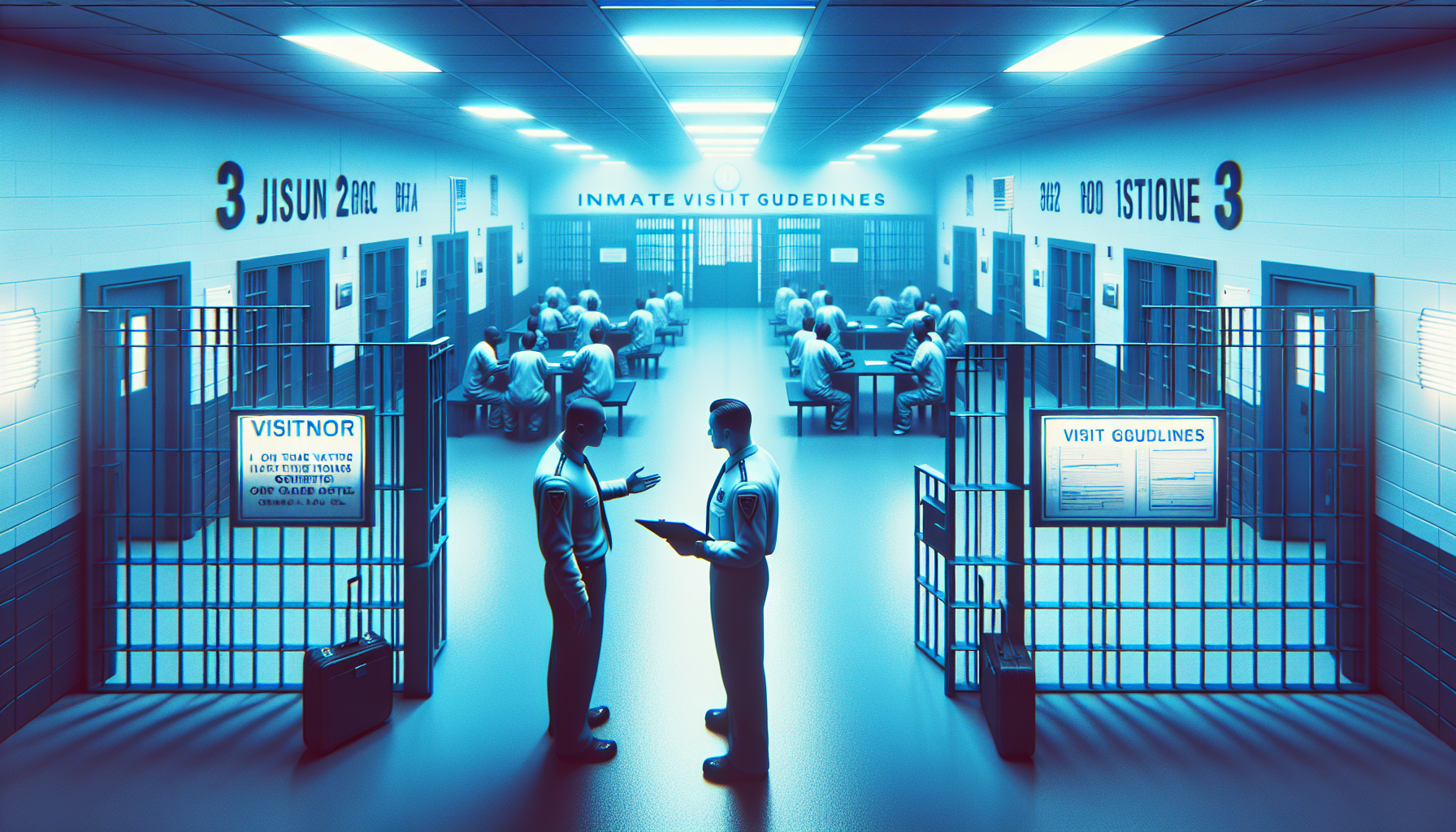Getting Ready for an Inmate Visit
Visiting an inmate isn’t just about showing up; it’s about knowing the ropes and having your ducks in a row. We’re talking medical stuff, religious gear, and the scoop on service animals. Let’s jump in.
Medical Items and Documentation
Got a medical condition? Bringing in meds or medical gadgets? Make sure you have the paperwork to back it up. A doctor’s note is your golden ticket, listing the doc’s name, address, phone number, and medical license. And hey, keep it fresh—update that note every two years.
We’re not talking about a free-for-all here. Only bring what’s necessary and medically verified. Have your papers ready to avoid any hiccups.
Religious Items and Attire
Your faith matters, and you can bring religious items or attire needed for your beliefs. Here’s the catch—they might have to check it out before you go in. Don’t sweat it; this can be done privately with an officer.
Most places have religious texts like the Bible, the Koran, and the Torah. If they don’t have your text, bring yours but get a thumbs-up from the Visiting Sergeant or Lieutenant first.
| Item Type | Permissions Required | Inspection Process |
|---|---|---|
| Religious clothing | Yes | Might need a private inspection |
| Sacred texts | Yes, if not on site | Approval needed from a Lieutenant or Sergeant |
Service Animal Assistance
Need a service animal? No problem. Make sure you have all the right documents, and your helper should wear a harness or be marked. You both gotta pass through the metal detector together, and remember—not even for a second can you be separated from your service animal during the visit. And hey, you’re in charge of making sure your furry friend behaves.
Got the basics down? Awesome. For the full rundown, check out our detailed guides on inmate visitation regulations and inmate visitation restrictions. Happy visiting!
Visitor Regulations and Procedures
Seeing someone behind bars means jumping through a few hoops but knowing the ropes can make it a lot easier. Families need to get a handle on ID rules, visiting hours, and the security checks that are in place.
Identification and Registration
You’ll need to show who you are with some valid ID. When you get there, you’ll sign in by giving details like your name, when you’re visiting, who you’re seeing, and how long you plan to stay.
| Required Information | Description |
|---|---|
| Visitor’s Name | Your full name. |
| Date of Visit | When you’re visiting. |
| Inmate’s Name | Your loved one’s full name. |
| Length of Visit | How long you’ll be visiting. |
Need more info on the nitty-gritty? Check out the visitation application for inmates.
Visitation Hours and Policies
Inmates usually get at least half an hour to hang out with visitors each week. If you’re doing a video visit, they get no less than twenty minutes per session. Each place has its own schedule, so make sure you double-check the times before you head out.
For the nuts and bolts on visiting times, peek at the visiting hours for inmates page.
Security Measures and Monitoring
Keeping visits safe is key. Facilities have rules to keep out forbidden items. Your visit will probably be watched, maybe even recorded, all to make sure no funny business happens. These rules also let you know about special visits and contact limits.
Wanna know what to expect? Dive into the inmate visitation regulations and inmate visitation restrictions pages. By checking out this info, families can be ready and comfortable when visiting their loved ones.
What It’s Really Like for An Inmate
Want to know what prison life is like for your loved one? Let’s break it down. Here’s what you can expect from different types of prisons and how it affects inmates day to day.
The Locked-Down Life
In close security prisons, inmates’ movement is seriously limited. Think about it: they’re inside 24/7, no outside duties. Take Central Prison, for example – kitchen staff start cooking up meals as early as 3:30 AM, and they’re under a watchful eye the whole time, even getting frisked by guards.
Visiting friends and family at Central? It’s a no-touch affair, scheduled on Wednesdays, Fridays, Saturdays, and Sundays, for no more than 90 minutes. This specific schedule can really help families plan their visits. Want more on visitation rules? Check out this link.
| Aspect | Details |
|---|---|
| Movement | Majorly restricted |
| Kitchen Shift Start Time | 3:30 AM |
| Visiting Days | Wed, Fri, Sat, Sun |
| Visit Duration | 1 – 1.5 hours |
The Middle Ground
In medium security prisons, inmates have a bit more room to breathe but are mostly still inside. They might get jobs, but with armed officers watching—think road squads or farm work.
There’s a little freedom here: inmates can join various programs, from religious services to educational classes, until 9:30 PM. After that, it’s lights out in their dorms. This structured environment with opportunities for personal growth can help pass the time. Need to know how to set up a visit? Here’s the scoop: visitation application details.
| Aspect | Details |
| Facility Stay | 24/7 |
| Job Assignments | Supervised work |
| Program Hours | Until 9:30 PM |
| Dorm Return Time | Nighttime |
The Homestretch
Minimum security prisons are for inmates nearing release. Here, they might join community work squads, prepping for life on the outside. The vibe is way more laid-back.
Evenings from 7 to 9 PM are for programs, then back to shared dorms, which can hold up to 150 people. Visiting might feel a bit more relaxed too, giving families a better sense of connection. For the lowdown on visitation rights, visit this page.
| Aspect | Details |
| Work Opportunities | Community work squads |
| Evening Activities | 7 PM to 9 PM |
| Dorm Capacity | Up to 150 inmates |
Getting the nitty-gritty on inmate life in close, medium, and minimum security prisons helps families grasp what their loved ones are facing and how visiting works. Still got questions? More answers await at the FAQ page.
Visiting Room Experience
Visiting a loved one in prison is hardly a walk in the park. Knowing the rules before you go can make the experience less stressful for everyone involved.
Getting In and the Wait
When you arrive at the facility, there are certain hoops you’ve got to jump through. First, you need to show a valid ID – think driver’s license or something government-issued with your picture on it. Then comes the registration where you jot down stuff like your name, the inmate’s name, and how long you plan to stay. Pro tip: Hand over your pass when you get to the visiting room; otherwise, you don’t get in.
If you hit the facility during peak visiting times, you might have to cool your heels for a bit before you can see your loved one. It’s smart to show up early to get through all the entry hassles. For exact times, check out the visiting hours for inmates on the facility’s schedule.
The Room and Its Big Brother
Visiting rooms can vary, but they usually have tables and chairs set up so you can chat with your loved one in relative privacy. If you need special furniture or help, give the visiting staff a heads-up.
Security is no joke here. The room will have correctional officers and cameras keeping an eye on you. These measures are to keep everyone safe and sound.
Rules of Engagement
There are some rules you need to follow during your visit. You can usually talk freely, but physical contact like hugs or kisses might be restricted depending on the facility’s rules.
All visits are watched and might even be recorded, so keep everything above board. Make sure you know the inmate visitation regulations and any specific inmate visitation restrictions for the facility you’re visiting. This will help you steer clear from breaking any rules you didn’t know existed.
Understanding these aspects can make the whole visiting ordeal a bit easier. If you’ve got questions, the inmate visitation FAQ is a handy resource for common queries.









